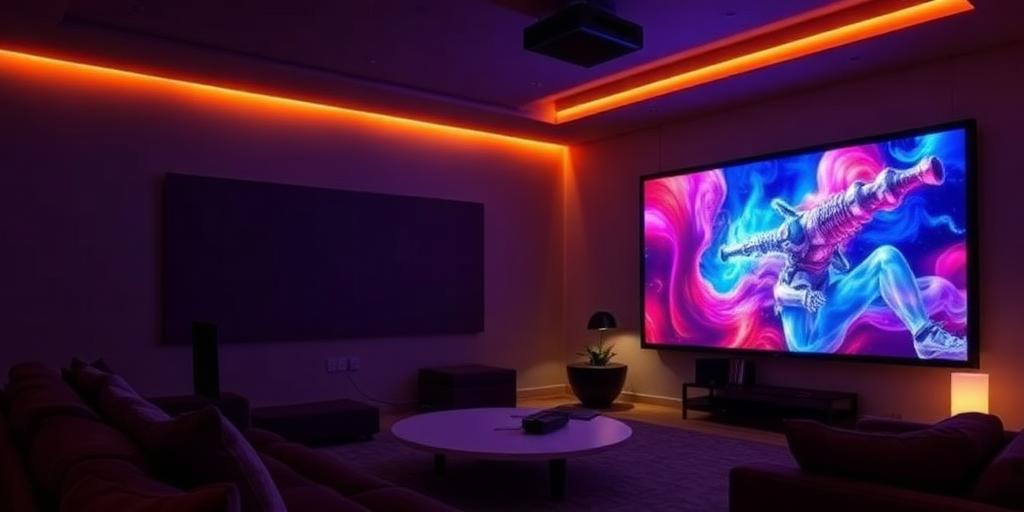The Ultimate Guide to Projectors for a Big-Screen Experience
For enthusiasts seeking an immersive viewing experience, traditional televisions often fall short of replicating the grandeur of a cinema. This is where the projector steps in, transforming any space into a dynamic, large-format display. Understanding the intricacies of projector technology is paramount to making an informed decision and achieving an unparalleled big-screen experience. This comprehensive guide delves into the essential aspects of projectors, empowering you to select and optimize the ideal system for your needs.
Why Opt for a Projector?
Projectors offer distinct advantages over large-screen televisions, primarily in scalability and immersive potential. While even the largest consumer TVs cap at around 100-120 inches, a projector can effortlessly cast images exceeding 150 inches, often up to 300 inches, providing a truly cinematic scale. This expansive canvas is ideal for home theaters, gaming, educational presentations, and sports viewing, delivering a visual impact that fixed-panel displays cannot match. Furthermore, the absence of a large, static black rectangle when the system is off contributes to a cleaner, less obtrusive aesthetic in your living space.
Key Projector Technologies Explained
The core technology within a projector dictates its performance characteristics. Understanding these distinctions is crucial:
- DLP (Digital Light Processing): Known for sharp images, excellent contrast, and minimal pixelation. DLP projectors use a DMD (Digital Micromirror Device) chip composed of millions of tiny mirrors.
- LCD (Liquid Crystal Display): These projectors use three separate LCD panels (one for red, green, and blue light) to create the image. They typically offer good color saturation and are often more light-efficient than DLP in certain price segments.
- LCOS (Liquid Crystal On Silicon): A hybrid technology combining elements of both LCD and DLP, LCOS projectors (such as Sony's SXRD and JVC's D-ILA) deliver exceptional black levels, high contrast, and a smooth, film-like image without a visible pixel structure. These are often found in higher-end home theater models.
- Laser and LED Projectors: Beyond the display technology, the light source is a critical factor. Laser and LED projectors offer significantly longer lifespan (20,000+ hours) compared to traditional lamps (2,000-6,000 hours), faster power-on/off, and often consistent brightness and color performance throughout their lifespan. While initially more expensive, their low maintenance cost can offset the premium.
Critical Specifications for Your Big-Screen Experience
Evaluating projector specifications is vital to ensure it meets your performance expectations. When choosing a projector, prioritize these factors:
- Resolution: For a true big-screen experience, 4K (3840 x 2160 pixels) is the current gold standard, offering incredible detail and clarity. 1080p (1920 x 1080 pixels) remains a viable option for budget-conscious buyers, particularly for screens under 100 inches.
- Brightness (Lumens): Measured in ANSI lumens, this indicates the light output. For dedicated dark home theaters, 1,500-2,500 lumens suffice. In rooms with ambient light, 3,000+ lumens are often necessary to maintain image vibrancy.
- Contrast Ratio: This metric (e.g., 20,000:1) represents the difference between the brightest white and the darkest black. A higher contrast ratio results in more dynamic images with greater depth and detail in shadows.
- Throw Ratio: This determines the distance a projector needs to be from the screen to achieve a certain image size. A short-throw projector can create a large image from a very short distance, ideal for small rooms or avoiding shadows from viewers. Standard-throw and long-throw models require more distance.
- Connectivity: Ensure the projector has sufficient HDMI inputs (HDMI 2.0 for 4K/HDR content), USB ports, and potentially optical audio output or Ethernet for smart features.
- HDR (High Dynamic Range) Support: For the richest colors and contrast, select a projector compatible with HDR10 or Dolby Vision.
Optimizing Your Projector Setup
The projector itself is only one component of the ultimate big-screen experience. Proper setup and environmental control are equally important:
- Projection Surface: A dedicated projector screen is highly recommended over a plain wall. Screens are designed to optimize image quality by reflecting light uniformly, enhancing brightness, color accuracy, and contrast. Different screen materials exist for various ambient light conditions (e.g., ALR – Ambient Light Rejecting screens).
- Room Lighting: For the best cinematic experience, control ambient light. Darkening the room with blackout curtains or blinds will dramatically improve image quality, particularly black levels and contrast.
- Audio System: A projector provides visuals; high-quality audio is essential for true immersion. Invest in a dedicated sound system, such as a soundbar with a subwoofer, or a full surround sound receiver and speaker setup.
- Mounting: Decide between ceiling mounting for a permanent, clean installation or a tabletop placement for portability. Ensure stable positioning to prevent image distortion.
Maintenance and Longevity
To ensure your projector provides years of optimal performance, regular maintenance is advisable. Clean the lens with a microfiber cloth, regularly clean or replace air filters (if applicable) to prevent dust buildup and overheating, and ensure adequate ventilation around the unit. For lamp-based projectors, be mindful of lamp hours and have a replacement ready as the lamp approaches its end-of-life.
Conclusion
Embarking on the journey to create a big-screen experience with a projector is a rewarding endeavor. By carefully considering the technology, key specifications, and optimizing your viewing environment, you can achieve a cinematic spectacle that rivals or even surpasses commercial theaters in the comfort of your own home. The investment in a quality projector system translates into countless hours of immersive entertainment, making it an indispensable centerpiece for any serious media consumer.









